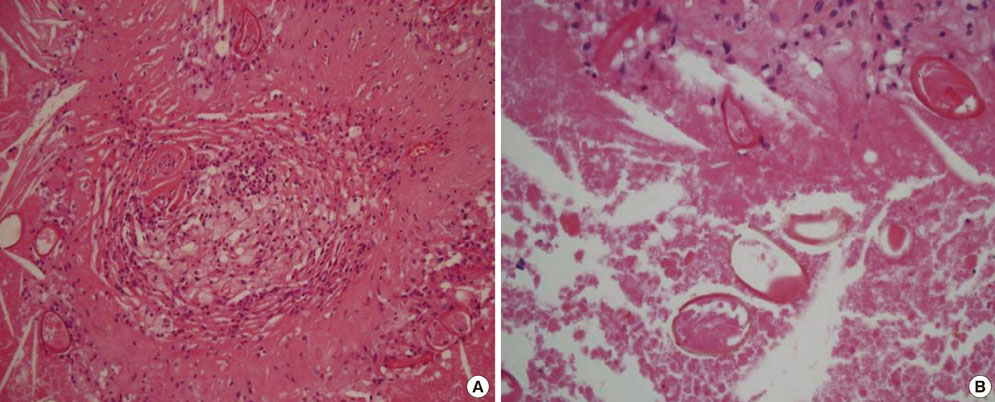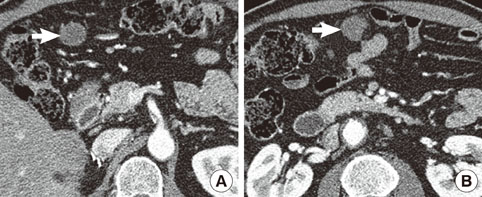Endocrinol Metab.
2011 Mar;26(1):97-100. 10.3803/EnM.2011.26.1.97.
A Case of Incidentally Diagnosed Adrenal Paragonimiasis
- Affiliations
-
- 1Division of Endocrinology and Metabolism, Department of Internal Medicine, St. Vincent's Hospital, The Catholic University of Korea, Suwon, Korea. ybahn@catholic.ac.kr
- 2Department of Surgery, St. Vincent's Hospital, The Catholic University of Korea, Suwon, Korea.
- 3Department of Diagnostic Radiology, St. Vincent's Hospital, The Catholic University of Korea, Suwon, Korea.
- 4Department of Pathology, St. Vincent's Hospital, The Catholic University of Korea, Suwon, Korea.
- 5Department of Parasitology, College of Medicine, The Catholic University of Korea, Seoul, Korea.
- KMID: 2169133
- DOI: http://doi.org/10.3803/EnM.2011.26.1.97
Abstract
- We report here on a rare case of adrenal paragonimiasis that presented with an adrenal incidentaloma. A 52-year-old male presented with fatigue and weight loss. The laboratory findings revealed eosinophilia (8.5%) and an increased eosinophil count (910/microL). The computed tomography scan showed 6.5 x 5 cm sized multilocular cystic mass in the right adrenal gland, which was non-functioning, and cystic lesions with variable sizes were also noted in the abdominal cavity. On the surgical field, whitish patches were spread out in the peritoneum, the omentum, the dome of the liver and the diaphragm. The right adrenal gland was replaced by a cystic mass filled with mucopurulent creamy materials. The pathologic findings revealed numerous eggs of Paragonimus spp. Also, the ELISA was positive for IgG paragonimus antibody. The adrenal gland can become infected by various microbial pathogens, including parasites, although it is relatively uncommon. However, in the case of a cystic adrenal mass with accompanying eosinophilia in an endemic area, clinicians should consider the possibility of parasitic infection.
Keyword
MeSH Terms
Figure
Reference
-
1. Young WF Jr. Clinical practice. The incidentally discovered adrenal mass. N Engl J Med. 2007. 356:601–610.2. Young WF Jr. Management approaches to adrenal incidentalomas. A view from Rochester, Minnesota. Endocrinol Metab Clin North Am. 2000. 29:159–185.3. Bovio S, Cataldi A, Reimondo G, Sperone P, Novello S, Berruti A, Borasio P, Fava C, Dogliotti L, Scagliotti GV, Angeli A, Terzolo M. Prevalence of adrenal incidentaloma in a contemporary computerized tomography series. J Endocrinol Invest. 2006. 29:298–302.4. Song J, Li C, Tong C, Yang H, Yang X, Zhang J, Deng Y. Evaluation of left ventricular rotation and twist using speckle tracking imaging in patients with atrial septal defect. J Huazhong Univ Sci Technolog Med Sci. 2008. 28:190–193.5. Kloos RT, Gross MD, Francis IR, Korobkin M, Shapiro B. Incidentally discovered adrenal masses. Endocr Rev. 1995. 16:460–484.6. Cicala MV, Sartorato P, Mantero F. Incidentally discovered masses in hypertensive patients. Best Pract Res Clin Endocrinol Metab. 2006. 20:451–466.7. Paolo WF Jr, Nosanchuk JD. Adrenal infections. Int J Infect Dis. 2006. 10:343–353.8. Muta K. Dawes B, editor. Paragonimus and paragonimiasis. Advances in parasitology. 1965. London and New York Academic Press Inc.9. Hahn ST, Park SH, Kim CY, Shinn KS. Adrenal paragonimiasis simulating adrenal tumor--a case report. J Korean Med Sci. 1996. 11:275–277.10. Toppino M, Serra GC, Bolla C, Capalbo MT, Capuzzi P, Comorio A, Mistrangelo M. Adrenal location of the echinococcus. Considerations on a clinical case. Minerva Gastroenterol Dietol. 1996. 42:221–225.11. Akcay MN, Akcay G, Balik AA, Boyuk A. Hydatid cysts of the adrenal gland: review of nine patients. World J Surg. 2004. 28:97–99.12. Kamishima T, Harabayashi T, Ishikawa S, Kubota KC, Nonomura K, Omatsu T, Onodera Y, Shirato H, Terae S. Alveolar hydatid disease of the adrenal gland: computed tomography and magnetic resonance imaging findings. Jpn J Radiol. 2009. 27:225–228.13. Cho SY, Kong Y, Yun DH, Kang SY, Kim LS, Chung YB, Yang HJ. Persisting antibody reaction in paragonimiasis after praziquantel treatment is elicited mainly by egg antigens. Korean J Parasitol. 2000. 38:75–84.14. Liu Q, Wei F, Liu W, Yang S, Zhang X. Paragonimiasis: an important food-borne zoonosis in China. Trends Parasitol. 2008. 24:318–323.15. Choi DW. Paragonimus and paragonimiasis in Korea. Korean J Parasitol. 1990. 28:Suppl. 79–102.16. Im JG, Kong Y, Shin YM, Yang SO, Song JG, Han MC, Kim CW, Cho SY, Ham EK. Pulmonary paragonimiasis: clinical and experimental studies. Radiographics. 1993. 13:575–586.17. Na BK, Kim SH, Lee EG, Kim TS, Bae YA, Kang I, Yu JR, Sohn WM, Cho SY, Kong Y. Critical roles for excretory-secretory cysteine proteases during tissue invasion of Paragonimus westermani newly excysted metacercariae. Cell Microbiol. 2006. 8:1034–1046.18. Shin MH, Kita H, Park HY, Seoh JY. Cysteine protease secreted by Paragonimus westermani attenuates effector functions of human eosinophils stimulated with immunoglobulin G. Infect Immun. 2001. 69:1599–1604.





